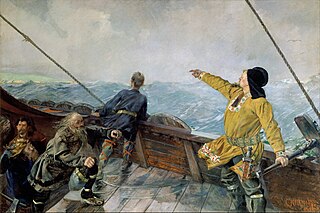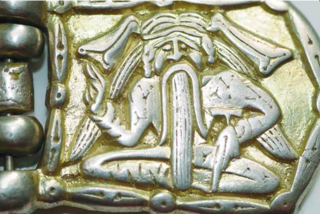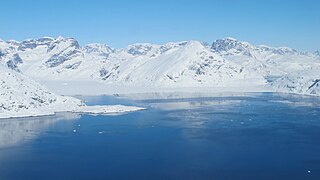Eskimo is an exonym that refers to two closely related Indigenous peoples: Inuit and the Yupik of eastern Siberia and Alaska. A related third group, the Aleut, who inhabit the Aleutian Islands, are generally excluded from the definition of Eskimo. The three groups share a relatively recent common ancestor, and speak related languages belonging to the family of Eskaleut languages.

Inuit religion is the shared spiritual beliefs and practices of the Inuit, an indigenous people from Alaska, northern Canada, parts of Siberia, and Greenland. Their religion shares many similarities with some Alaska Native religions. Traditional Inuit religious practices include animism and shamanism, in which spiritual healers mediate with spirits. Today many Inuit follow Christianity ; however, traditional Inuit spirituality continues as part of a living, oral tradition and part of contemporary Inuit society. Inuit who balance indigenous and Christian theology practice religious syncretism.
The Sun and Moon is an unipkaaqtuat, a story in Inuit folklore. The traditional explanation for the movement of the Sun and Moon through the sky is that a brother and sister are constantly chasing each other across the sky. The story also explains the moon's dappled gray appearance as soot smeared on his face.
In Inuit religion, Nerrivik or Nerivik was the sea-mother and provider of food for Inuit. She was the patron of fisherman and hunters. In Canada, she was known as either Sedna or Arnapkapfaaluk and in Greenland, she was Arnakuagsak.
In Inuit religion, Silap Inua or Sila is similar to mana or ether, the primary component of everything that exists; it is also the breath of life and the method of locomotion for any movement or change. Silla was believed to control everything that goes on in one's life.
The Adlet are a race of creatures in the Inuit mythology of Greenland, as well as the Labrador and Hudson Bay coasts. While the word refers to inland native American tribes, it also denotes a humanoid dog-legged tribe. The lower part of the body of the canine Adlet is like that of a dog and their upper part is like a man's. All Adlet run quickly, and their encounters with men usually end with man as the victor.
Kiviuq, also spelled Qiviuq, Kiviok and other variants, is a legendary hero of the epic stories of the Inuit of the Arctic regions of northern Canada, Alaska and Greenland. Versions of his adventures vary with the location and the storyteller. In Greenland he is known as Qooqa. In Alaska he is called Qayaq, which is short for Qayaqtuaġiŋñaqtuaq.

The Cape York meteorite, also known as the Innaanganeq meteorite, is one of the largest known iron meteorites, classified as a medium octahedrite in chemical group IIIAB. In addition to many small fragments, at least eight large fragments with a total mass of 58 tonnes have been recovered, the largest weighing 31 tonnes. The meteorite was named after Cape York, a prominent geographic feature located approximately 30 miles (48 km) west of the east coast of Meteorite island and the nearby peninsulas in northern Melville Bay, Greenland, where the first meteorite fragments were discovered.

The Eastern Settlement was the first and by far the larger of the two main areas of Norse Greenland, settled c. AD 985 – c. AD 1000 by Norsemen from Iceland. At its peak, it contained approximately 4,000 inhabitants. The last written record from the Eastern Settlement is of a wedding in Hvalsey in 1408, placing it about 50–100 years later than the end of the more northerly Western Settlement.

Masks among Eskimo peoples served a variety of functions. Masks were made out of driftwood, animal skins, bones and feathers. They were often painted using bright colors. There are archeological miniature maskettes made of walrus ivory, dating from early Paleo-Eskimo and from early Dorset culture period.

Traditional Alaskan Native religion involves mediation between people and spirits, souls, and other immortal beings. Such beliefs and practices were once widespread among Inuit, Yupik, Aleut, and Northwest Coastal Indian cultures, but today are less common. They were already in decline among many groups when the first major ethnological research was done. For example, at the end of the 19th century, Sagdloq, the last medicine man among what were then called in English, "Polar Eskimos", died; he was believed to be able to travel to the sky and under the sea, and was also known for using ventriloquism and sleight-of-hand.

Hungarian shamanism is discovered through comparative methods in ethnology, designed to analyse and search ethnographic data of Hungarian folktales, songs, language, comparative cultures, and historical sources.
Sirenik or Sireniki are former speakers of a divergent Eskimo-Aleut language in Siberia, before its extinction. The total language death of this language means that now the cultural identity of Sirenik Eskimos is maintained through other aspects: slight dialectal difference in the adopted Siberian Yupik language; sense of place, including appreciation of the antiquity of their settlement Sirenik.

Inuit are a group of culturally and historically similar Indigenous peoples traditionally inhabiting the Arctic and subarctic regions of North America, including Greenland, Labrador, Quebec, Nunavut, the Northwest Territories, Yukon (traditionally), Alaska, and Chukotsky District of Chukotka Autonomous Okrug, Russia. Inuit languages are part of the Eskimo–Aleut languages, also known as Inuit-Yupik-Unangan, and also as Eskaleut. Inuit Sign Language is a critically endangered language isolate used in Nunavut.
Dr. Erik Holtved was a Danish artist, archaeologist, linguist, and ethnologist. He was the first university-trained ethnologist to study the Inughuit, the northernmost Greenlandic Inuit.

Dr. Hinrich Johannes Rink was a Danish geologist, one of the pioneers of glaciology, and the first accurate describer of the inland ice of Greenland. Rink, who first came to Greenland in 1848, spent 16 winters and 22 summers in the Arctic region, and became notable for Greenland's development. Becoming a Greenlandic scholar and administrator, he served as Royal Inspector of South Greenland and went on to become Director of the Royal Greenland Trading Department. With "Forstanderskaber", Rink introduced the first steps towards Greelandic home rule.

Ticasuk Brown (1904–1982) was an Iñupiaq educator, poet and writer. She was the recipient of a Presidential Commission and was the first Native American to have a school named after her in Fairbanks, Alaska. In 2009, she was placed in the Alaska Women's Hall of Fame.

King Frederick VI Coast is a major geographic division of Greenland. It comprises the coastal area of Southeastern Greenland in Sermersooq and Kujalleq municipalities fronting the Irminger Sea of the North Atlantic Ocean. It is bordered by King Christian IX Land on the north and the Greenland Ice Sheet to the west.

Nathalie Sophia Nielsine Caroline Rink née Møller was a Danish writer and ethnologist. Together with her husband Hinrich, she founded Greenland's first newspaper, Atuagagdliutit, in 1861. She is credited as being the first woman to publish works on Greenland and its culture.
The Goose Wife is a mythical female character that appears in tales from the Inuit and other ethnic groups that dwell across the circumpolar Arctic region. The usual story is that the geese alight on land, become women by taking off their goose-skins and bathe in a lake. However, they are unaware that a human hunter is spying on them, and he steals the goose-skin of one of them, forcing her to be his wife. Due to the great similarities between both characters, the goose wife has been compared to the swan maiden, another female that alternates between human and bird forms.









